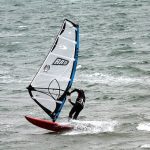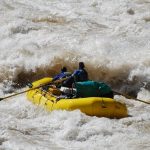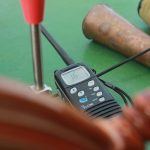As summer nears, water sports are a great way to enjoy the warm weather.
There are many different activities you can enjoy, but before getting to it, you should first know the different water sports equipment needed for the specific water sport you want to try.
Having the proper equipment will make your experience more enjoyable!
There can be a lot of gear involved in water sports, which can be overwhelming. It’s possible that you might already have some of the gear you need for water sports around your house and not even know it.
If you’re worried about getting to know your water sports equipment, don’t worry! I’m here to help. I’ve broken down the different types of equipment into categories, from wearables to boats, boards and accessories.
I’ll also tell you which water sport each piece of equipment is used for, and give you some important tips to keep in mind before you make a purchase.
Water Sports Equipment — Different Types and Use
Wetsuit
Believe it or not, this is essential for sports such as surfing, kayaking, jet-skiing, open water swimming, freediving, or any water sports that involve dealing with water temperatures ranging from 10°C – 25°C.
A wetsuit helps avoid hypothermia by trapping a thin layer of water between your body and the suit. The water is warmed by your body temperature, which keeps you warm.
The most important factor to consider when choosing a wetsuit is the temperature of the water because the thickness of the wetsuit depends on this.
The other important factor is the thickness of the wetsuit. A thicker wetsuit will obviously provide more warmth than a thinner one. The fit and thickness of a wetsuit are both important factors to consider when choosing one.
A wetsuit should be as tight as possible to avoid cold water entering, which would decrease the body’s ability to retain heat. A thicker wetsuit will provide more warmth than a thinner one.
The wetsuit should fit snugly around your wrists, neck, and ankles to ensure both security and body heat retention.
It’s also important to consider what your wetsuit is made of. Rubber is usually the best material in terms of performance, as opposed to materials like neoprene.
This is because neoprene can soak up water and get heavy over time.
Dry Suit
A drysuit is not the same as a wetsuit because it does not make you wet. It is also a better choice than a wetsuit for colder water sports.
There are several things you should consider when choosing a dry suit. Make sure to check the zippers and seals to make sure they are in good condition.
Also, pay attention to the fit and material of the suit. These details are important because dry suits are designed specifically to keep water out and maintain body heat, preventing hypothermia.
A drysuit must fit snugly and securely around the wrists, ankles, and neck, similar to a wetsuit. Make sure to follow the sizing chart of the drysuit’s manufacturer to ensure that you get the perfect fit.
There are two types of drysuits to choose from: neoprene and membrane. Neoprene drysuits are thicker and provide more warmth on their own, while membrane drysuits are lightweight and require additional undergarments for warmth.
Rash Guards
This sport’s equipment, also known as a rash vest, provides protection against the damaging rays of the sun, preventing sunburn. Some rash guards even have build-in UV protection.
Wetsuits can also be worn as an undergarment for a dry suit to add warmth. They are perfect for activities such as snorkeling, freediving, wakeboarding, bodysurfing, windsurfing, canoe polo, and kite surfing.
When you are choosing a rash guard, fit is an important consideration. However, the fit of your rash guard can be either tight or loose, depending on the water sports activity you will be participating in.
Some rash guards come with Ultraviolet Protection Factor (UPF) 50+ sun protection, which can help prevent your skin from being damaged by the sun’s harmful rays while participating in water sports activities.
Personal Floatation Device (PFDs)
PFDs, or personal flotation devices, differ from traditional life jackets in that they are meant to be worn constantly. This makes them much more comfortable to wear and ideal for water sports that involve immersion, such as white water rafting or paddling.
One downside to PFDs is that they do not provide the same level of protection as life jackets. It can be more difficult to stay afloat with a PFD, and they generally do not help to turn an unconscious person onto their back in the water for easy breathing.
Why is a PFD better than a life jacket? PFDs provide much more maneuverability and a wider range of motion, which are necessary when it comes to sports like white water rafting or paddling than life jackets.
The size and type of personal floatation device (PFD) you need depends on your chest size and the activity you’ll be doing. To measure your chest, find the widest part and wrap a tape measure around it.
To test the fit, put on the PFD over the clothes you’ll wear while using it. You should be able to move freely and comfortably.
Last but not least, try out your PFD in shallow waters to check its effectiveness and to make sure it won’t slip off or float up while you’re in the water.
Snorkel Mask
A snorkel mask helps you see better when you’re in the water. It forms a pocket of air around your eyes or face, making things more clear.
There are two main factors to consider when choosing the best snorkel mask: comfort and durability. I recommend buying from snorkel gear manufacturers who provide high-quality snorkel and diving equipment.
Most snorkel masks nowadays have snorkel tubes attached to them, which reduces the amount of gear you need to worry about.
Snorkeling Fins
Fins that are good for snorkeling, diving, and swimming are the best choice as they provide extra power to your legs while underwater and make it easier to swim around.
They also help you to float more easily, keeping your legs from getting tired or cramped.
To choose the best snorkeling fins for you, look for fins with flexible yet durable blades, a snug fit, and adjustable straps. If you are unsure of your size, choose fins with open heels.
What Water Sports Innovations Catch Consumer Interest?
The water sports industry is focusing on equipment and accessories with automated technology. In order to stay competitive, manufacturers of water sports equipment are releasing new products that incorporate IOT (Internet of Things) technology.
According to Ericsson’s Mobility Report and Internet of Things Forecast, 18 billion IoT devices will be in use by 2022. This trend is being driven by the introduction of numerous tech-powered marine devices.
These inventions are providing individuals with uncommon adventures, beyond traditional beach activities. As a result, sales of cutting-edge equipment to support an adrenaline-filled beach vacation are increasing.
For example, people who enjoy water sports are very pleased with the invention of electric surfboards. This type of board allows the user to ride waves coming from the opposite direction.
The goal of this innovation was to make it possible to surf without depending on waves or the need to paddle. With the introduction of the Zapata Flyboard, water sports have become even more high-tech. This is considered to be one of the most advanced water sports inventions by enthusiasts.
The Flyboard is propelled into the air by a water propulsion system. This system gives the person riding the Flyboard the ability to fly up to 49 feet in the air or dive down to a depth of 8 feet underwater.
Interesting Facts about Water Sports Equipment
- The advancement of water sports has resulted in increased interest in recreational water sports activities, which is aiding the global expansion of the water sports equipment and accessories market. Growing consumer interest in outdoor recreational activities, combined with greater involvement across all age groups, has fuelled the construction of numerous water sports facilities worldwide.
- North America region had a major share in terms of volume as well as value in the global Water Sports Equipment and Accessories market in 2021 and is presumed to dominate over the forecast period.
- Dry Top technology is a new snorkeling technology that was introduced. This technology prevents water from entering a snorkeler’s mouth and nose. When submerged, the top of a dry snorkel is blocked by a variety of improved devices like flaps and valves. Unlike typical snorkels, this function eliminates the need to periodically empty the snorkel when returning to the water’s surface.
- The key players in the global water sports gear market are focusing on notable strategies to overcome competition and maintain and improve their global market share.
Top 10 Players in the Water Sports Equipment and Accessories
The key players in the global Water Sports Equipment and Accessories market in terms of value include Speedo International Limited, Arena S.p.A., KAP7 International, Inc., Baden Sports, Inc., Apollo Sports USA Inc., Mikasa, Billabong International Limited, Nike, Inc., Adidas AG, Aqua Lung International, Johnson Outdoors, Inc., Beuchat, Cressi, Seavenger, Sherwood Scuba, and Aquatec – Duton Industry Co., Ltd.
These key players are concentrating on new product developments as well as technological innovation to enhance their products in Water Sports Equipment and Accessories to gain competitive market share at a global level.
For instance, Bixpy, a San Diego-based firm, has developed a jet propulsion system that can be used for a variety of water activities. Standup paddle boarders, divers, kayakers, and other sports fans can use this method.
The water scooters that are 20 feet long claim that they are budget-friendly for enjoying on the water. They are supposed to be used for water sports and relaxing at the beach.
Top 10 Countries in the Water Sports Equipment Market
In the global Water Sports Equipment and Accessories market, the major countries are the US, Canada, China, Japan, Australia, Germany, France, Italy, Spain, and the UK.
The largest market share is in the United States. In 2021, roughly 14 % (aged six and up) participated in water sports. Similarly, in 2020, 17.1 % in the United States reported participating in water sports, making them the generation with the greatest participation rate.
Growing consumer awareness of the importance of health and fitness, as well as the rise of e-commerce, are some of the primary drivers of the water sports equipment and accessories market in the United States.
Constant advances in the materials used in the construction of sports equipment help to improve product performance and, as a result, the rate of adoption.The National Whitewater Center in Charlotte, North Carolina has the world’s largest artificial river, which is good for rafters and kayakers.




